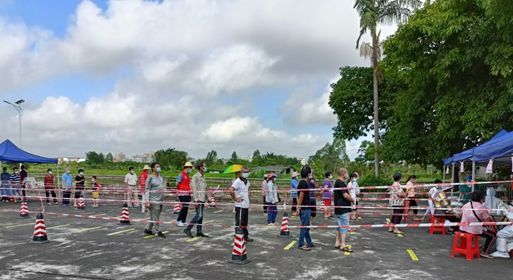Zeng Qianyun, Fengbo Chen
South China Agricultural University

Villager waiting for Covid-19 tests in Baisha village, Taishan city, Guangdong, China
Photo: Fengbo Chen
The COVID-19 pandemic spread globally at an unanticipated rate, causing severe shocks to the world economy and global labor markets. After implementation of the lockdown policy, employment opportunities declined, unemployment rates rose, and problems of poverty became prominent. With the launch of vaccination programs and the relaxation of epidemic control measures, industries resumed work and economies achieved some level of normality.
Nevertheless, the COVID-19 pandemic revealed how interrelated industrial and rural communities are. Rural non-agricultural labor resources play an important part in industry in China. In fact, rural families are increasingly dependent on non-agricultural labor income, which is becoming the main source of income for rural families. The difficulty of stable growth of industrial income has increased as a result of the pandemic, and the job stability of non-agricultural workers has been further reduced. This has brought great uncertainty to rural incomes, given the close relationship between urban industries and the rural hinterlands in which they are situated.

Committee members and volunteers controlling the entrance to Huangnitan village in Enping county, Guangdong Province during the lockdown in 2020.
Photo: Fengbo Chen
Vulnerable occupations in non-agricultural labor
Most rural non-agricultural employment is unorganized, informal and private sector – working in construction, manufacturing and service industries. Having shrunken the labor market, the pandemic particularly affected temporary workers whose main source of income is daily wage labor. This left millions in severe financial hardship, with no livelihood guarantees, growing unemployment and mounting debt. During the pandemic, in order to avoid the risk of infection, factories were shut down, and intensive contact activities were largely prevented, leaving an unstable work environment and causing greater vulnerabilities for workers.
Changes in the age structure of the workforce
After the outbreak of COVID-19, the proportion of people working from home has increased. This has driven the use of new knowledge and technology, leaving the older labor force further behind, with a weaker ability to accept new knowledge, new technology and new experience – and to switch careers. In bad times, it is inevitable to face problems of layoffs and unemployment. For older rural non-agricultural laborers who are still working abroad, it is even more difficult to transfer jobs.
There are differences in the age structure between urban and rural areas, and when there are differences in age, physical health also varies. The median age of the rural group is higher than that of the urban group, and so are mortality rates. The overall age is relatively older, their health is relatively disadvantaged, and competitiveness in the labor market is weak, which may also lead to a narrower non-agricultural working age range in rural areas than for urban migrant workers.
The resilience of education to shocks
Non-agricultural labor with higher education levels can effectively withstand the impact of the epidemic, and they are more willing to learn independently and/or participate in training to acquire new skills that will help them into work. On the one hand, people with higher education levels are less at risk of being laid off. Workers with higher education levels are also better able to find and seize opportunities, making timely adjustments in response to the pandemic.
Today, the Covid-19 situation is changing fast, and there is a trend towards normalization of epidemic prevention and control. Small and medium-sized enterprises are facing the risk of bankruptcy, which endangers the stability of rural non-agricultural employment and affects the income of this key group. The labor market is further diminished overall, and the demand for young highly educated workers is growing, which increases the survival pressure on rural non-agricultural workers.
In addition to the need for more targeted policies to expand and consolidate the employment opportunities of rural non-agricultural laborers and reduce their unemployment risks, rural non-agricultural laborers also need to actively improve their quality and ability to resist risks in order to adapt to changing labor market needs.





